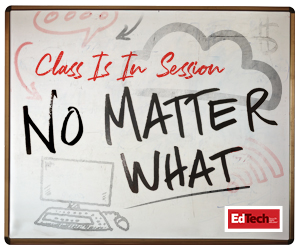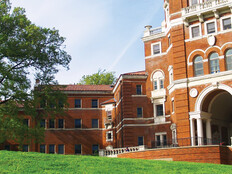Enjoying the Flexibility of Outdoor Higher Ed Classrooms
“One of the great things about these spaces is the flexibility they offer,” says Trey Conatser, associate director of the Center for the Enhancement of Learning and Teaching at the University of Kentucky. Last spring, UK put up nearly a dozen “campus canopies” that could accommodate between 16 to 48 people.
The Wi-Fi-equipped tents, supported by Ubiquiti and Cisco technologies, come furnished with sanitizing stations, tables and chairs. Some are left open throughout the day and are available on a first-come, first-served basis. Others may be reserved ahead of time by instructors and student study groups.
“You can go in there and you can have it be as tech-enhanced or tech-free as you want,” Conatser says. Many students find the tents are especially useful when they don’t have time to make it home for their next online class. “If you have a class in-person that finishes at 9:50 and your next class is remote starting at 10, it’s a place where you can plug in your device without having to cross the entire campus,” he says.
Conatser also reminds universities that these classrooms need to be accessible to students and staff with disabilities — especially if the spaces become permanent. “Be sure to involve faculty and students in the design process,” says Trey Conatser.
MORE ON EDTECH: Learn how universities can help disabled students with remote learning.
Do’s and Don’ts for Outdoor Classrooms
University leaders say outdoor learning spaces have been relatively easy to set up. But that doesn’t mean their deployment went smoothly.
Jonathon Hunter, production manager for the Department of Dance at The Ohio State University, says he and his colleagues initially thought that removing seating from an indoor theater would give them enough space to maintain social distancing. Before long, they realized that didn’t suffice. The university needed a lot more learning spaces outside to accommodate everyone.
Their solution? A tent that stretches more than 3,000 square feet. Equipped with a specialized floor similar to those found in indoor dance studios, the tent also includes lighting and a dedicated sound system. It didn’t help that the tent was located next to a busy street. “We discovered early on that our instructors were having trouble projecting their voices with their masks on,” he explains “But the audio system took care of that. Once they had microphones, they could speak to the entire room,” Hunter says.
A final challenge, Hunter recalls, was reliable Wi-Fi. The university anticipated increased demand for connectivity soon after the pandemic began. The IT team launched an ambitious initiative to ensure outdoor wireless access was available across the entire campus.
MORE ON EDTECH: See what technologies colleges need for outdoor classrooms.
The IT department installed more than 300 HPE Aruba AP-375 and -377 wireless access points. “They’re easy to put in, and they’re outdoor rated. They give you the same experience you’d expect if you were inside,” says Mike Hiatt, OSU’s Director of Networking and Network Architecture.
Unfortunately, the dance department set up their tent where there were no wireless APs yet. They also unknowingly positioned it over a maintenance hole cover that IT needed to access.
“We had to be able to stream so students could attend class remotely … so having wireless at the tent was critical,” Hunter says. The university ultimately decided the most practical solution was a Wi-Fi hotspot. “We just put it in a cart that the instructors wheel out before the start of class each day,” he says.
Another word of advice from Hunter: Don’t skimp on power. “If you’re running electric to the site, add an extra line. If you don’t, you’re going to wish you had later,” he says.
Outdoor Learning Spaces Are Here to Stay
Hunter estimates that OSU dance classes relied on the tent for 10 weeks last fall. They stopped using it when the temperatures dipped to the point where instructors could not stay warm. “We purchased a couple of space heaters, but they weren’t enough, and they ended up blowing a circuit,” he says.
As is the case at many higher ed institutions, spring classes at OSU run only until the end of April. In Columbus, Ohio, where the university is located, temperatures at that time of year rarely make it above 50 degrees Fahrenheit.
“That may be a bit too cold for our performers, but I’m sure we can find other uses for tents,” Hunter says.
Even if the pandemic ends by next fall, Hunter still looks forward to teaching outdoors. “We liked having this outdoor space available. I know I’d be interested in using it again,” he says.










